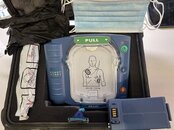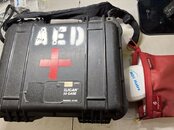Please explain what advantage knowing pulse O2 in the field will provide for one administering first aid on site for dive related issue (not talking about EMS)?
If one has O2 to administer then it should be administered, if one does not have O2 to administer then one can ponder obtaining/purchasing O2 for the future while administering other first aid protocols.
What would you expect a first responder to do differently knowing pulse O2 levels that they would not already be doing?
The tendency with gadgets like this is tunnel vision, where the responder spends more time looking at what the device is indicating and thinking about how they should respond to it than just provide sound first aid based on established protocols.
Your money is better spent on CPR/First aid/O2 Administration certification or recertification than on pulseoximeter.
Knowing pulseO2 changes nothing in the field from a first responder/patient care perspective. In fact responding specifically to PO2 levels indicated by pulseoximeter by first responder who does not have more advanced medical/emergency response training can open the first responder to liability issues for administering care beyond their training. If the OP fell into the category of advanced medical/emergency response they would not have asked the question in the first place.
Bottom line is that one can spend their money on any gear/equipment/gadget they want, but there really is nothing useful or practical that a pulseoximeter and it’s readings bring to a first responder scenario…perhaps use that money to invest in a portable AED, much more useful when the occasion for use presents itself.
-Z
That’s a lot of questions, I will do my best to address all.
A pulse ox is a very useful diagnostic tool. What do all of the following have in common
Patient’s beside monitor in a hospital room
LIFEPAK 15 on the ambulance
$25 Pulse Ox from CVS
They all have a probe that monitors the O2 level in the patients tissue and that is a key indicator of your patients oxygenation/perfusion status. Without the Pulse Ox, you would have to rely on signs (things you can see) like blue lips or the Patients mental status has become altered. Both of those are late signs that inadequate perfusion is happening.
I see no issue whether a FA provider has a Pulse Ox or not, they are sold over the counter, but there are legal liability issues to purchasing, possessing and administering O2. The Good Samaritan law only protects the provider who is operating within their level of training and is meeting the Standard of Care. Read, do no harm.
How can we in the field help fix that before late signs are apparent? If we have a pulse ox and the PO2 reading is below 94% we give oxygen. Current protocols are no longer that every Pt. get O2, nor we give O2 at 95%or below, the latest protocol is below 94%.
I don’t know that it makes any difference if we are talking about a dive related issue or EMS. The patient either needs O2 and ventilatory support or they do not. In a dive boat related setting, where a long travel time to get the patient to the next level of care, because the area the boat is operating in and can not get a medievac to remove the Patient quickly, knowing the O2 sat’ level can be even more important, since on a dive boat there is finite/limited amount of O2 on board and you want to use that supply when the patient needs it, if their condition is worsening and not waste it when they are perfusing adequately and do not need O2. Giving O2 when its needed to a person who is in shock is an important treatment to getting your patient out of shock or delaying the onset of decompensating shock.
As for the possession of an Medical grade O2 and the proper masks to deliver it to the patient. Oxygen is an FDA regulated drug that requires either a Doctors prescription or a Medical license in order to purchase it and possess it. Typically, if not on the bus and the Medic wants O2 for their own kit, you go to a welding supply vendor they take a copy of your EMS license, vet you with the state , open an account for you and fill your tank with medical grade O2. So, anyone who just wants to have O2 for their first aid kit, can not have it, since they lack the proper training and license to legally obtain it.
As for the AED, while having one and the proper training to use it is great, an AED is also regulated. To legally possess an AED, at least in my state, you must either have a prescription from a Doctor or have an EMS license to legally purchase one. Of course, anyone can buy anything they want on Ebay. If we are concerned about the cost of a $25 Pulse Ox breaking the bank, then how can one purchase a $1,000-1,500 AED along with the items needed to use an AED and maintain it, i.e. (Fast Response kit) Pocket Mask, scissors, gloves, safety razor, small towel. Let’s not overlook CPR / AED certification which expires every 2 years. Then you must replace the AED battery every 2 years or less $150 and you need 2 sets of AED pads @ $75 each set, which also expire every 2 years. Also, not a bad idea to buy a Pelican box to put your AED and fast response kit in, so that the AED will be protected from damage and working, when it is finally needed.
Since we are talking about a dive related medical emergency, lets say for example you have a patient who has an air embolism which has lodged in the Pulmonary Artery which carries deoxygenated blood from the heart to the lungs. Now as this embolism/blockage restricts the flow of deoxygenated blood into the lungs, which will also reduce the flow of oxygenated blood to the body, which is Obstructive Shock, wouldn’t you want to know that the amount of oxygenated blood in the container is being reduced and your patient is becoming hypoxic? The pulse ox will indicate that trend.
Another advantage of the pulse ox is that for the lone medical provider who only has two hands, once determining by comparing a pulse taken by palpation and compared to the pulse rate that is also shown on a pulse Ox is accurate, you no longer have to take 15-30 seconds every 5 minutes to take your patients pulse by palpating, you can get it from the pulse ox, this allows you to work on other injuries or tasks, since you do not have to tie up one hand for 15-30 seconds every 5 minutes, that this patient requires their vitals to be taken.
I am not a Dive Medicine Doctor. I believe training always trumps equipment. I have seen many times on this forum people say Tech diving is not cheap and if you cant afford it, you should not be doing it. Well, setting up a Trauma bag or getting the proper training is not cheap either and among the cheapest things that you will buy for your kit to stock it, is a $25 pulse ox diagnostic tool. For reference, today’s prices a box of band aids is $10.





